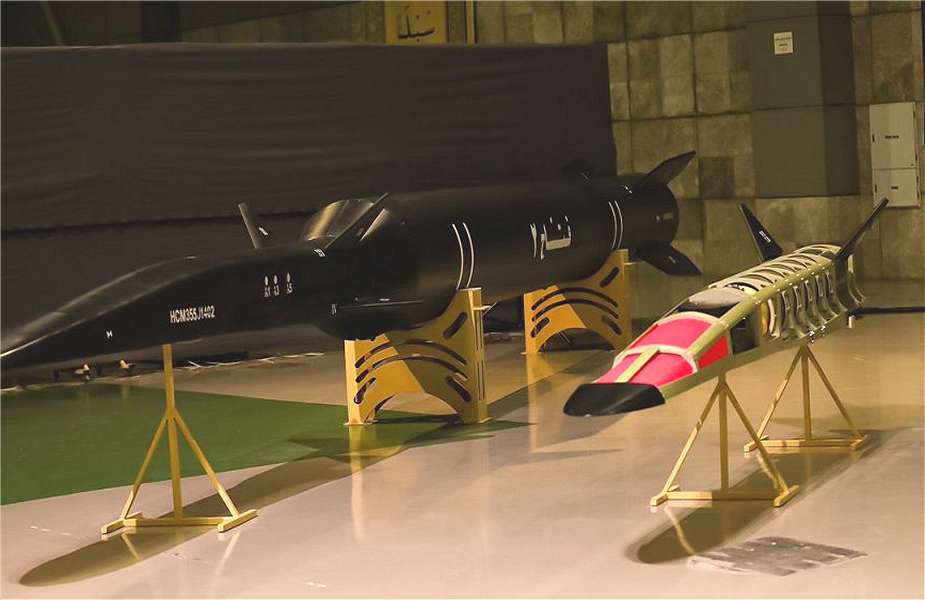Iran Launched Non-Interceptable Hypersonic Missile Fattah-2 during Airstrike Against Israel
According to Iranian media, Iran conducted its first aerial attack using the newly unveiled hypersonic missile, Fattah-2, during airstrikes against Israel. This missile is considered non-interceptable. The attack, which was launched on April 13, 2024, targeted multiple Israeli airbases and marked Iran's first combat deployment of this advanced missile technology.
Follow Army Recognition on Google News at this link

The Fattah-2 Iranian-made hypersonic missile was unveiled in November 2023. (Picture source Twitter IranObserver)
According to information published on April 15, 2024, by "Press TV", an Iranian state-owned news network, the Islamic Revolution Guards Corps (IRGC) successfully deployed the Fattah-2 missile, striking key Israeli military infrastructure. ABC News has confirmed from a senior US official that the strike impacted two airbases in Israel, with Nevatim Air Base suffering considerable damage. Infrastructure hit included a C-130 military transport plane, a runway, and storage facilities. Meanwhile, another undisclosed airbase in the Negev Desert also came under fire, though it reportedly sustained less significant damage.
Hypersonic weapons, capable of traveling faster than Mach 5 — five times the speed of sound — present significant challenges to missile defense systems due to their high speed and agility. Iran has reported that its Fattah missile can achieve speeds up to Mach 15, or fifteen times the speed of sound.
Iran's development of hypersonic missile technology, particularly the Fattah series, marks a significant advancement in its military capabilities and has implications for regional security dynamics. The unveiling of the Fattah-1 hypersonic missile in June 2023, as reported by various sources, represented a pivotal moment in Iran's defense technology efforts.
The Fattah missile development aligns with Iran's strategic goal to enhance its deterrent capabilities amid ongoing regional tensions. The missile's design incorporates features such as a movable nozzle and the ability to operate both within and outside the Earth's atmosphere, which allows it to evade interception by sophisticated defense systems. This technological leap was emphasized during its public introduction, which coincided with the anniversary of the death of Hassan Tehrani Moghaddam, considered the father of Iranian missile technology. The symbolism underscores the missile’s importance to Iran's defense strategy and its ongoing efforts to achieve a security balance through indigenous technological advancements.
Iranian sources claim that the Fattah-2 missile, which was first publicized during a visit by Supreme Leader Ayatollah Ali Khamenei to an IRGC aerospace facility in November 2023, is a sophisticated addition to Iran's arsenal. This missile features liquid fuel propulsion and boasts a range of up to 1,500 kilometers, equipped with a 450 kg warhead capable of maneuvering mid-flight to elude missile defenses.
In its design, the Fattah utilizes forward aerodynamic fins in the first stage to stabilize and guide its trajectory immediately after launch. The second stage combines a sustainer with thrust vector control (TVC) and re-entry vehicle (RV) aerodynamic fins. These components are critical as they allow the missile to adjust its path dynamically, enhancing its accuracy and making it more difficult to intercept.
The physical dimensions of the Fattah missile include a body diameter of approximately 1 meter and a length of about 15.3 meters. It has a substantial take-off weight of around 12 tons, which includes nearly 9 tons of propellants, highlighting its significant payload capacity. The re-entry vehicle itself weighs about 1 ton, and it can carry a warhead weighing between 350 to 450 kilograms.
For navigation and guidance, the Fattah employs an inertial navigation unit (INU) and a global navigation satellite system (GNSS), which includes GPS and GLONASS systems. This dual-system guidance ensures that the missile can maintain a course with high precision, with an assessed circular error probable (CEP) accuracy ranging from 10 to 25 meters. The missile's warhead is a high-explosive type, designed to deliver substantial damage upon impact.
The development and deployment of the Fattah-2 highlight significant advancements in Iran's missile technology, notably its capacity to reach hypersonic speeds and its enhanced maneuverability. Such characteristics are believed to challenge the effectiveness of even the most sophisticated air and missile defense systems currently deployed by Israel.
Military experts suggest that the integration of technology used in Iran’s satellite launch rockets into the Fattah-2’s design has played a crucial role in its operational success. The missile’s re-entry vehicle (RV) is particularly notable for incorporating a thrust-vectoring solid-propellant motor, which activates during the terminal phase to adjust the missile's trajectory, further complicating interception efforts.
These developments reflect Iran's broader military strategy to maintain a robust deterrent capability in a volatile regional context, where technological superiority can often shift the strategic balance. As such, the introduction of hypersonic technology into Iran’s arsenal poses new challenges for missile defense strategists globally, prompting reassessments of current defense postures and capabilities.
Defense News April 2024
- Hits: 11162
















